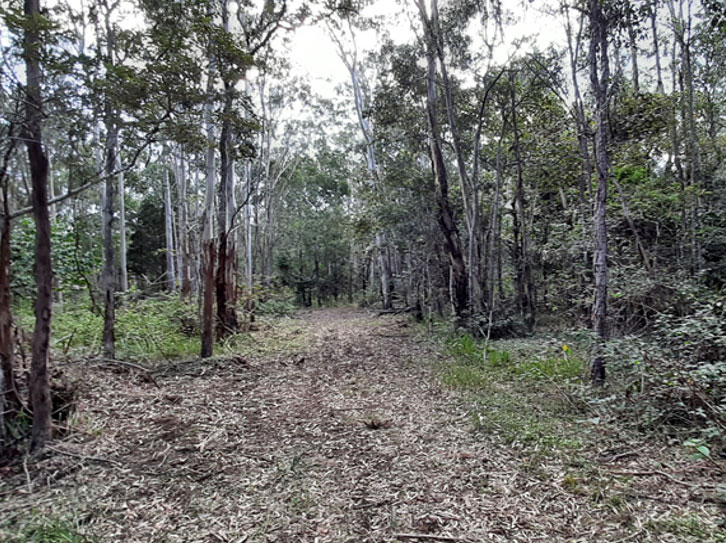Oakview National Park—Threat management


Protecting habitats from future bushfire
To reduce the risk of a future bushfire impacting the core habitat for both the Oakview leaf-tailed gecko and the Nangur spiny skink, a 6.9km fireline was established in Oakview National Park utilising old forestry tracks. This enhanced capacity for an emergency fire response, alongside the usual range of fire management operations, such as planned burns to reduce fuel hazards.
The existing fire strategy for Oakview National Park led to planned burns in the 18 months prior to the 2019 bushfire, which served to protect the core habitats of the priority species. A review of the fire strategy for Oakview National Park was still undertaken after the 2019 bushfire to incorporate the changed conditions and priorities to protect refugia for these threatened species. Planned burns will continue to be conducted in fire-adapted forests adjacent to the vine forest, steered by the fire-management guidelines for the relevant regional ecosystem.
Controlling invasive weeds
Weeds can quickly establish and expand their range after fire, hindering the natural regeneration process. Invasive weeds identified as a significant threat to the habitat of the Oakview leaf-tailed gecko and the Nangur spiny skink were targeted for additional control efforts, outside of the established weed control programs. This included Cat's claw creeper (Dolichandra unguis-cati) which is a perennial woody vine that climbs and forms dense mats that can smother native vegetation including within vine forests, reducing the availability and quality of habitat and food resources. Control of infestations at Oakview National Park includes ongoing use of herbicide and the release of jewel beetles (Hylaeogena jureceki) as biocontrol agents with local Landcare groups.
Coral berry (Rivina humilis) was another priority weed, as it can invade ecosystems with a dense tree canopy, dominating the understorey and displacing natural ground cover thereby reducing sunlit areas used by reptiles for basking. Manual control efforts initiated in 2013 for core habitat areas of the Nangur spiny skink at Nangur National Park were extended through this project to include the habitat of this species and the Oakview leaf-tailed geckoat Oakview National Park. Ongoing monitoring and targeted control of coral berry has been incorporated into the revised weed management strategies, with an objective to prevent new infestations establishing in critical habitat areas
Lantana (Lantana camara) and high-biomass grasses, such as Guinea and green panic (varieties of Megathyrsus maximus), can occur in dense populations along tracks and the disturbed margins of core habitats for the priority threatened species, increasing the risk from future fires. The extent of these weeds was reduced and with the ongoing programs for weed control and planned burning, the level of fuel hazards will be much lower and the vine forest habitats better protected.


Controlling pest animals
Predation by feral cats and foxes, as well as impacts from wild deer were identified as significant threats to the Oakview leaf-tailed gecko and the Nangur spiny skink. At Oakview National Park, cameras were deployed to monitor pest animal activity and guide the best locations for control efforts. Felixer lethal grooming traps were successfully set to target feral cats that can quickly learn to exploit localised reptile populations, especially a burrow-dependant species such as the Nangur spiny skink. To protect the small Nangur spiny skink population at Nangur National Park, additional controls were implemented to reduce predation by cats and foxes, and burrow disturbance by pigs. Deer can browse post-fire regeneration of native plants, spread weeds and significantly disturb and compact the ground layer, impacting skink burrows and causing the loss of rocky shelters for geckos. Feral red deer were successfully trapped in Oakview National Park and improvements to the technique will support ongoing control programs.
Reducing human impacts
Human interference with Oakview leaf-tailed geckos and Nangur spiny skinks, such as collecting for the wildlife trade, or handling for photography (which can introduce lethal diseases and cause stress) were identified as a threat to the ongoing survival of these critical populations. Public access to the core habitats was restricted through the closure of gazetted roads, installation of gates, fencing and cameras to monitor unauthorised access.
Captive breeding
The loss of genetic diversity in the small remaining populations of the Nangur spiny skink also presents a significant risk to their conservation. A recently established captive breeding program was therefore supported by the customised design and construction of a second breeding enclosure. This will house the growing number of offspring being bred through successful husbandry to augment wild populations or establish new wild populations and reduce the risk of extinction.


